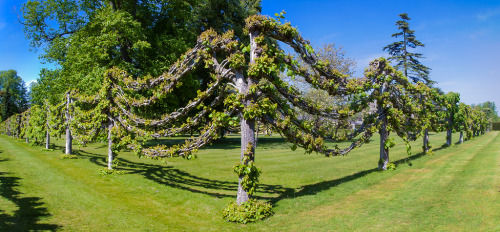biodiverseed:Living Structures: PLEACHINGA plant is considered to be ‘inosculate’if it is self-graft
biodiverseed:Living Structures: PLEACHINGA plant is considered to be ‘inosculate’if it is self-grafting; if the branch of one individual will, as the resultof gentle abrasion, form a living bond with the branch of another individual,or with another branch of the same plant. When this grafting is aided orinitiated by humans, the process is called ‘pleaching.’In mediaeval Europe, in areas where annual flooding endangeredhuman settlements, the pleaching of inosculate trees was employed as a solutionto what otherwise might have been an insoluble problem. The trees were plantedon a grid, like a small orchard. As they grew, branches were pruned andtrained along this grid, so that eventually the branch of one tree met thatof its neighbour. At that point, an incision was made in the bark of bothbranches and they were tied together, like blood brothers or sisters. Theanalogy is deserved, in that not only did these branches grow together toform one member, but their support activities (condition of water/mineralsand sap) merged, thereby joining the life processes of the neighbouringtrees.Read moreDiagram: McGill Architecture // Photo: Angus KirkMore on living sculptures and grafting -- source link
Tumblr Blog : biodiverseed.tumblr.com

